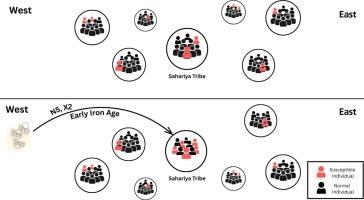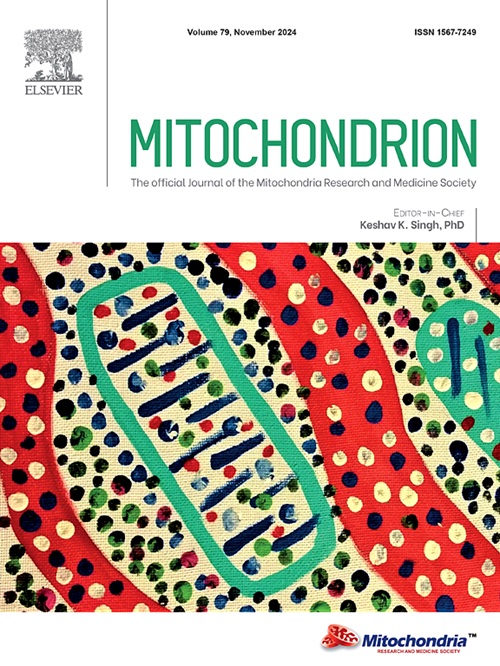Outlier maternal haplogroups N5 and X2 and their potential role in elevated tuberculosis prevalence among the Sahariya tribe
IF 4.5
3区 生物学
Q2 CELL BIOLOGY
引用次数: 0
Abstract
India bears the largest burden of tuberculosis (TB) cases in the world. Prior studies have highlighted significantly higher pulmonary TB among the Sahariya tribal population in Central India. The disease susceptibility of a population to disease may be influenced by genetic ancestry. In this context, we investigated the maternal genetic ancestry of the Sahariya in relation to their neighbouring tribal populations. For this study, we used the largest available dataset (n = 729), comprising 140 Sahariya individuals and 589 individuals from adjacent caste and tribal groups (including 50 newly sequenced samples). Our detailed mtDNA analysis revealed the exclusive presence of two rare haplogroups N5 and X2 which are completely absent in neighbouring tribal and caste populations. Further examination of the phylogeographic origins of the branches of haplogroups N5 and X2 suggests that these unique founder haplogroup branches (N5a and X2a) were likely introduced into the Sahariya from the western regions of the Indian subcontinent. The temporal expansion of these haplogroups indicates a gene flow from the western area to the Sahariya population during the early Iron Age. In addition to that, we have also analysed 33 SNPs for six TB-associated genes. We observed a single SNP (rs4958847-IRGM1) where the minor allele frequency was significantly different in Sahariya with their neighbouring populations. Consequently, our analysis of maternal genetic ancestry and known associated autosomal genes provides insights that may help explain the higher prevalence of TB among the Sahariya compared to their neighbouring populations.

母体异常单倍群N5和X2及其在撒哈拉部落结核病患病率升高中的潜在作用
印度是世界上结核病病例负担最重的国家。先前的研究强调,在印度中部的撒哈拉部落人口中,肺结核发病率明显较高。一个群体对疾病的易感性可能受到遗传祖先的影响。在这种情况下,我们调查了撒哈拉人的母系遗传祖先与其邻近部落人口的关系。在这项研究中,我们使用了最大的可用数据集(n = 729),其中包括140名撒哈拉人以及来自邻近种姓和部落群体的589名个体(包括50个新测序的样本)。我们详细的mtDNA分析显示,两个罕见的单倍群N5和X2在邻近的部落和种姓人群中完全不存在。对N5和X2单倍群分支的系统地理起源的进一步研究表明,这些独特的创始单倍群分支(N5a和X2a)可能是从印度次大陆西部地区引入撒哈拉沙漠的。这些单倍群的时间扩张表明,在铁器时代早期,基因从西部地区流向撒哈拉人。除此之外,我们还分析了6个结核病相关基因的33个snp。我们观察到单个SNP (rs 4958847-IRGM1),其中次要等位基因频率在撒哈拉人与其邻近人群中存在显著差异。因此,我们对母亲遗传祖先和已知相关常染色体基因的分析提供了见解,可能有助于解释撒哈拉人与邻近人群相比结核病患病率较高的原因。
本文章由计算机程序翻译,如有差异,请以英文原文为准。
求助全文
约1分钟内获得全文
求助全文
来源期刊

Mitochondrion
生物-细胞生物学
CiteScore
9.40
自引率
4.50%
发文量
86
审稿时长
13.6 weeks
期刊介绍:
Mitochondrion is a definitive, high profile, peer-reviewed international research journal. The scope of Mitochondrion is broad, reporting on basic science of mitochondria from all organisms and from basic research to pathology and clinical aspects of mitochondrial diseases. The journal welcomes original contributions from investigators working in diverse sub-disciplines such as evolution, biophysics, biochemistry, molecular and cell biology, genetics, pharmacology, toxicology, forensic science, programmed cell death, aging, cancer and clinical features of mitochondrial diseases.
 求助内容:
求助内容: 应助结果提醒方式:
应助结果提醒方式:


